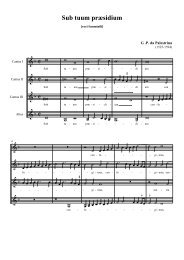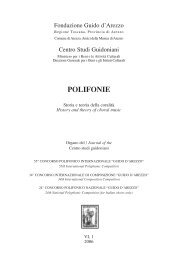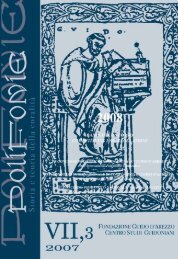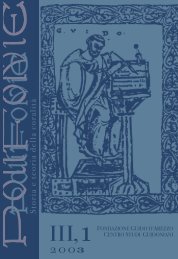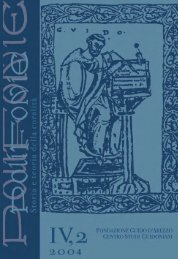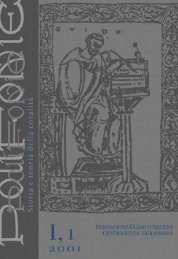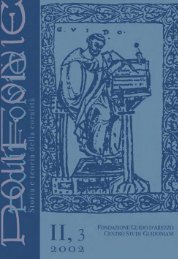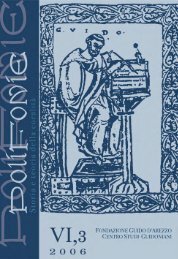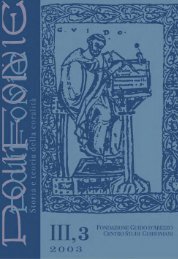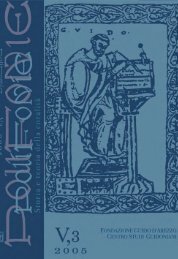Riviste Polifonie/119_2005 n 2.pdf - Fondazione Guido d'Arezzo
Riviste Polifonie/119_2005 n 2.pdf - Fondazione Guido d'Arezzo
Riviste Polifonie/119_2005 n 2.pdf - Fondazione Guido d'Arezzo
You also want an ePaper? Increase the reach of your titles
YUMPU automatically turns print PDFs into web optimized ePapers that Google loves.
MARCO GOZZI<br />
library and the fact that it also acted as a college and seminary. 3<br />
Both this early period of training and his study of counterpoint with the<br />
Servite Salvatore Essenga can be seen as the vital factors behind Vecchi’s<br />
great musical expertise and probably also his special regard for sacred music<br />
and plainchant.<br />
Vecchi’s sacred output has been scantly published, studied and performed.<br />
Apart from Rüegge’s important work, written almost forty years ago, 4 there<br />
are no thorough studies of his sacred polyphony. And yet for most of his life<br />
he occupied positions as maestro di cappella, directing the chapels in Salò,<br />
then Modena, Reggio Emilia (for just a few months), Correggio and again<br />
Modena.<br />
Neither the encyclopaedias nor the dictionaries make any mention of his<br />
belonging to religious orders, but in the Capitolo autobiografico he mentions<br />
wearing a habit. 5 Given that he was buried in the church of the Carmelites he<br />
may indeed have been a Carmelite friar. In any case this is a matter that needs<br />
further investigation, for it has considerable implications on his biography<br />
and, more specifically, his liturgical training.<br />
Among Vecchi’s sacred compositions there are also polyphonic works<br />
based on plainchant, such as the Hymni qui per totum annum in Ecclesia<br />
Romana concinuntur, Partim brevi stilo super plano cantu … elaborati cum 4<br />
vocibus, published in Venice in 1604 (the year before his death). I will not,<br />
however, dwell on these works (which could perhaps be the subject of another<br />
paper), but will instead draw attention briefly to a didactic work entitled<br />
Mostra delli tuoni della musica, which is in fact a treatise on polyphony, and<br />
not on plainchant. 6 A manuscript copy of the work, dated 1630, is preserved<br />
3<br />
As Lazzarelli observed nel 1711: “continuamente alimentavansi molti giovani Monaci per<br />
istruirli nelle Lingue Latina, e Greca, e nella teologia, sotto ottimi Lettori, com’è a tutti noto”,<br />
MAURO ALESSANDRO LAZZARELLI O.S.B., Informazione dell'Archivio di S. Pietro di Modena, 11<br />
voll. (1-7: final version, 8-11: draft), ms. in I-MOe, ital. 1001 = α.R 8.1-11, 1710-12 (voll. 1-<br />
6), 1712-1729 (vol. 7), vol. 3, p. 50; Lazzarelli draw this information from a protest sent in<br />
1567 by the monks to the bishop’s vicar in which they gave reasons for being exempted from<br />
the contribution that the religious orders of Modena were called upon to pay for the establishment<br />
of the city’s new seminary: among the reasons was precisely the fact that they themselves<br />
carried out the functions of a seminary for the monks.<br />
4<br />
RAIMOND RÜEGGE, Orazio Vecchis geistliche Werke, Bern-Stuttgart, Haupt, 1967 (Publikationen<br />
der Schweizerischen musikforschenden Gesselschaft, Serie II, 15).<br />
5<br />
“Fatti lingua, dico io, fatti d’acciaio / ch’a ragionar de’ vostri chiari gesti / bisogna ch’io mi<br />
stracci e cavi il saio”, quoted in ROSSANA DALMONTE - MASSIMO PRIVITERA, Gitene, canzonette.<br />
Studio e trascrizione delle Canzonette a sei voci d’Horatio Vecchi (1587), Florence, Olschki,<br />
1996, p. 10.<br />
6<br />
ORAZIO VECCHI, Mostra delli tuoni della musica, introduction and transcription by Maria Pollastri,<br />
presentation by Paolo Marenzi, Modena, Aedes muratoriana, 1987 (Biblioteca della<br />
Deputazione di storia patria per le antiche provincie modenesi, N.S., 93).<br />
34



